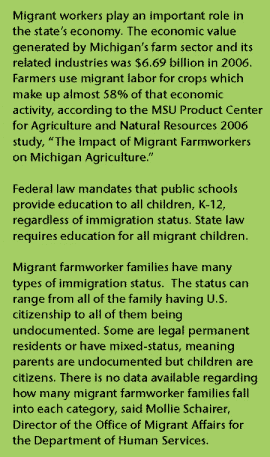The contribution by migrant workers to the economy is undeniable, with the literal fruits of their labor evident on grocery store shelves and in the millions of bushels of apples harvested and cherished in Michigan each fall. Migrants come for opportunity and work long, hard summers. Their children become a part of a school community, and educators describe serving their needs as rewarding, challenging and an always-moving target. This is the second in a three-part series about the migrant student population in Kent City Community Schools, and how teachers and administrators are stepping up to serve them.
Language. Transience. Cultural differences.
It’s easy to talk in abstract terms about challenges faced by the migrant families who work along West Michigan’s Fruit Ridge, where apples and peaches grow in abundanceduring the spring and summer months.
The obstacles one Kent City migrant family has overcome are detailed in Perla Vazquez-Juarez’s essay titled “My Michigan Hero,” an assignment for her eighth-grade English class.
Perla and her parents, Juan Vazquez and Ana Juarez Garcia, and her brother, Angel, 9, arrived in Michigan in July. Her English is limited, and Barb Barry helps translate.
Perla’s hero is her father, Juan. He could not afford high school in Mexico, where he worked as a machine operator for $200 a month. But he is very smart in science, math, carpentry and mechanics, she wrote. She describes how he taught her respect, responsibility and to work hard.
“My dad is my hero because he saved us,” she wrote. “We got out of Mexico. In Mexico, there are soldiers in the streets of every city because there are people in the most densely populated places who are killing each other.”
She describes relocating to many places to find work in Mexico before coming to the United States to pick apples. Here, Perla said, the streets are safe.
Juan Vazquez said he is proud of Perla. He hopes she and Angel “grow up well” and learn English.
“What they be when they grow up, is up to them decide,” he said.
Knocking on Doors and Knocking Down Barriers
At Kent City Community Schools, Barb Berry, teacher of English Learners and family liaison for the migrant population, and Will Lepech, elementary school principal, are working to guide migrant students and their families toward educational success. They have become advocates for the migrant families, “serving a population that doesn’t always have a voice,” Lepech said, and they want to help students like Perla to fulfill their dreams.
The daunting task involves a lot of footwork and paperwork to connect with Kent City Community Schools’ approximately 100 migrant students and families, said Berry, who has worked with the population since 2006.
“You are the narrow point of connection between them and the school,” Berry said.
The families pick crops, mostly apples, from about 20 surrounding farms. While the majority head south in the late fall, students attend local schools during the first semester and many attend the six-week Summer Migrant Program, where they have all-day school instruction, meals and field trips.
When families arrive in the spring, Berry works as the recruiter, knocking on door after door at camps, often waiting late into the evening for their return from the fields.
Keeping track of data is also important so students don’t lose credits. The nationwide Migrant Student Information Exchange helps ease the transition from school to school by keeping records of students’ education and health information, and to ensure high school students retain credits they have earned.
Still, learning loss can occur with every move, as students are absent for periods of time and have to resettle.
“A kid can lose four to six months of education with every move,” Berry said.
 Varied Needs
Varied Needs
When recruiting at camps, Berry provides families with paperwork like eligibility and enrollment forms they need to sign up for summerand regular school-year programs. She lets them know what services exist, and that there is a place for their children. She helps get them the resources they need for the classroom.
“These kids don’t come with graphing calculators,” she said.
Families’ needs for support are varied. Berry helped a widowed migrant father enroll his three children last fall. She spent two hours helping them get registered and fill out paperwork for free preschool for the 4-year-old child, and possibly after-school care. She calls it time well spent.
Services in Kent City include providing English language support and translation. All school correspondence is made available in English and Spanish. By law, every child is tested on the ability to read, write, speak and listen to English.
“By the time students are in the fifth grade they are translating to their parents,” Berry said.
Berry also leads the Vista Program, helping the Hispanic population read, write, speak and comprehend in English through a variety of interactive activities.
When it comes to standardized test scores and overall school performance, migrant students, of course, factor in.
“There are a lot of things you can’t control,” Berry said. “But there are things we can do proactively to meet the needs.”
The Migrant Education Program and Summer Migrant Education Program, funded by the state through federal funds, ensures all migrant children fully benefit from the same free public education provided to other children. The school receives the full per-pupil funding yearly allotment from the state for migrant students present on Count Day, when enrollment is determined.
Increasing Focus
Berry and Lepech are part of a big push to serve the families better. As director of federal grants that fund migrant programs, Lepech is focusing on boosting support in math, science and social studies, working with small groups, and building family literacy programs.
“We know from students, parents and staff that we need to better understand the needs and abilities of English Learners,” Lepech said. “As a former general education classroom teacher, I know all too well from past experience how unprepared I was to address the needs of these students.”
He said students are not adequately progressing in language development, and scoring low in mathematics, science and social studies. A certified interventionist, Lance Boehm, has been hired to work specifically with migrant students.
In the spring, family literacy will be a huge focus. Lepech is making a big push to bring migrant families to family literacy nights and get family members reading at home in Spanish and English. Bins full of literacy resources and texts will be brought to the camps.
Increased dialogue with growers is also planned to coordinate communication efforts.
While there is work to be done, Lepech said the latest standardized test scores have shown improvement for Hispanic and Limited English Proficiency students, with an indication that the “achievement gap” — the difference between highest and lower scores broken down between groups of students — is narrowing, Lepech said.
CONNECT
Michigan Department of Education Migrant Education Program








